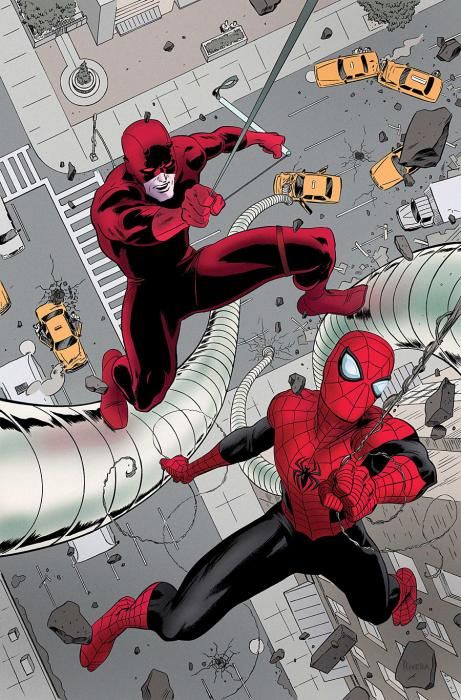In "Daredevil" #22 by Mark Waid and Chris Samnee, the Man Without Fear has his first run-in with the new, "Superior" Spider-Man. It's a semi-obligatory detour from the larger "Daredevil" story, because Spider-Man and Daredevil are historically friendly. Sooner or later, the two would meet again.
Waid makes this inevitable convergence more resonant than the average team-up by linking it to the themes of friendship and deception that have been playing out in Daredevil's life already. The lead-in focusing on blindness and money is a great slice-of-life, and shows Daredevil depends on the kindness of strangers and friends -- a reminder that he is burdened by a disability as much is he is graced with agility and strength.
Chris Samnee's artwork is a visual delight, and the amount of background detail he draws makes Daredevil's life look vibrant and full without being cluttered. There's wonderful depth in the restaurant scene. Samnee renders individual rose petals in the foreground and the individual meatballs in the pasta set before a hungry Matt Murdock. In the first fight sequence, Daredevil runs towards a Spider-Man's dark silhouette in the center of an inky web. It's a perfect, striking complement to Daredevil's sudden doubts voiced in the text box overhead. Samnee's composition is exquisite, too. He really gets across Daredevil's elegant movements and acrobatic precision as the Man Without Fear backflips out of his civilian clothes and vaults backward through a window.
Javier Rodriguez colors "Daredevil" #22 in rich, deeply saturated shades of red and purple, balanced against a complementary yellow sky. These unusual, daring choices work feel natural and Rodriguez's palette defines the current look of "Daredevil" almost as much as Samnee's pencils and inks. Both Samnee and Rodriguez's art and Waid's writing have a old-fashioned or retro feel to them, with a tone and look that feels innocent, pure and light-hearted, untouched by "Watchmen" or "Dark Knight Returns"-type grittiness and darkness. In the current comics market, "Hawkeye" and "Daredevil" have done a lot to make straightforward ethics and plain old superhero-ing cool again.
Like "Hawkeye" writer Matt Fraction, Waid has a gift for delivering flippant wit with touches of character depth. His dialogue is light and sparkling, and the rhythm of his prose is easy and pleasing. Waid is so good with language and comic timing that it's worth reading "Daredevil" #22 just for the jibes and jokes. My favorite moment was Daredevil ID'ing Spider-Man by his "gangly-ass posture."
The faults in "Daredevil" #22 lie in the plotting. There are just too many coincidences. I appreciate Stilt-Man's presence if only for how Samnee renders the visual spectacle of the villain stomping through the city, like a skinny metallic Godzilla. The timing of Stilt-Man's grand entrance feels classic, but it's a very stage-managed moment. The further revelation that Stilt-Man has a connection with Doc Ock's technological research is too much to swallow. This little nugget was created and thrown in there for the sole reason of needling the new Spider-Man into slipping up and giving Daredevil more reason to suspect there's something off about his old buddy. Similarly, while the opening scene of "Daredevil" #22 is subtle, the closing scene has parts that are forced and manipulative, especially when Murdock launches into a prosy, heavy-handed "lessons learned" script.
Despite the light tone, "Daredevil" #22 has an ominous undercurrent. Superior Spider-Man struggles to fill a costume that doesn't quite fit him. He dangles dangerously closer to the ever-present precipice of being discovered. This underlying grimness and fear jumps into full view near at end of the issue, with a different character. Foggy reveals something that Daredevil, with all his heightened senses and observant mind, has failed to detect. Thus, closing panel is beautifully poignant, drawing both contrasts and similarities between two troubled friendships, Matt and Foggy vs. Daredevil and Spider-Man.

